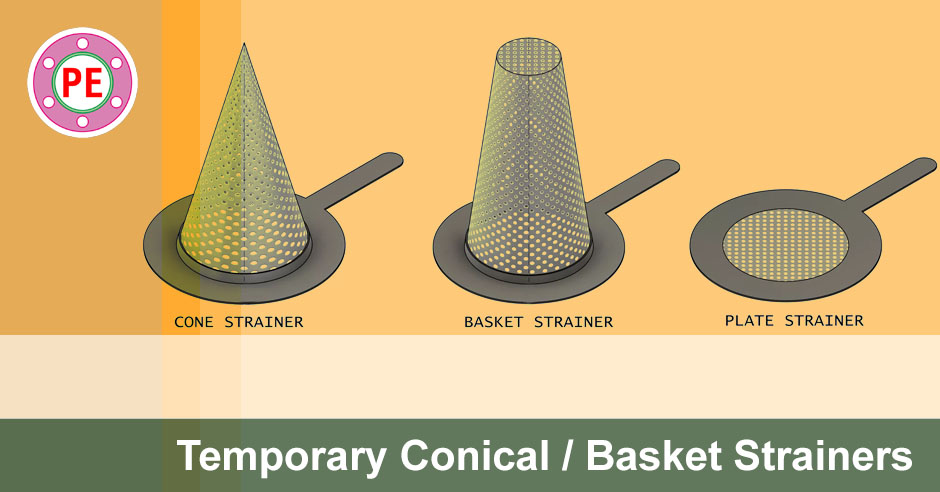Temporary Strainer
Temporary strainer is a startup strainer, also known as conical strainer or basket strainer, and is installed in a system to remove unwanted debris from the process stream. These strainers come in conical as well as basket shape along with plate strainers.
Tags : #Piping_Engineering #Piping_Materials #Piping_Fittings #Piping_Strainers #Conical_Strainers

Where Used..?
Temporary strainer is installed to protect a flow meter, pump, control or relief valves or other pieces of equipment during startup.
During construction, materials may become trapped in the line. These materials could be welding slag, welding rod, pieces of wood, cigarettes, rocks, etc. Many pieces of equipment will become damaged if this debris enters it. After start up is completed, the startup strainer should be removed.

[google-square-ad]
Materials of Construction
Materials of construction of a strainer should be compatible with the fluid. Most commonly used materials of construction are :
- Stainless Steel : 304, 306 etc.
- Monel Metal
Dimensional Standards
Dimensions of conical strainers are manufacturer specific. Main disc of conical strainers is made to fit between flanges of rating as per main pipe specification. Check out these dimensions for conical and basket strainers as per EATON catalog.
Conical Stainers
| Metric Dimensions | 150# | 300# | 600# |
| Inch Dimensions | 150# | 300# | 600# |
Basket Strainers
| Metric Dimensions | 150# | 300# | 600# |
| Inch Dimensions | 150# | 300# | 600# |
Design Requirements
- If a strainer cannot withstand high temperatures or differential pressures, it could come apart and cause damage to equipment.
- The expected pressure drop across the strainer should not cause the downstream operating pressure to fall below the minimum required pressure of the line e.g. NPSH for a pump.
- The perforations of the strainer should be slightly smaller than the smallest piece of debris that is expected to flow through it.
- If the perforations are too small, a high pressure drop could develop across the strainer and cause it to fail.
Installation in Piping
- Strainer should be easily removed by adding a pipe support or pipe stand close to the strainer and/ or a removable spool so that the strainer can be removed easily.
- It should be possible to remove the temporary strainer without shutting down the process with the help of a redundant piece of equipment that can be used while the strainer is being removed, or with block valves to allow bypass the strainer.

Installation for Orifice Meter
- Do not install a strainer immediately upstream of a piece of equipment that is sensitive to the flow regime, such as an orifice plate.
- If possible, install the strainer downstream.
Strainer plate thickness considerations
- A the flange, the temporary strainer is usually 1/16” thick and it also requires two gaskets.
- When the strainer is removed, it must be decided how will the pipe be connected again without double or triple stacking gaskets.
- Spacer can be used in place of temporary strainer based on company policy.
- A temporary strainer can add 1/8” to the length of the bolts.
- Some companies require full thread engagement when installing piping and the extra 1/8” can be added to the bolt size.
Cone direction upstream or downstream..?
- Installation of a conical strainer can be done in one of two different ways, cone facing upstream or cone facing downstream.
- When cone is downstream, debris collects inside of the cone near the tip and cone may rip apart due to heavy strain on the tip.
- Advantage of cone downstream side is easier removal of debris. But mechanical strength of cone shall be ensured.
- When cone is upstream, debris collects to the side of the strainer. Its advantage is that any plugging of the strainer will start in the outside and work its way in.

